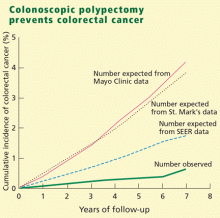Understanding current guidelines for colorectal cancer screening: A case-based approach
ABSTRACTAfter a polyp or polyps are discovered on colonoscopy, many patients are being told to come back for repeat colonoscopy unnecessarily soon, thus diverting a scarce resource away from patients who may derive the most benefit—those with high-risk polyps and those who have never been screened.
KEY POINTS
- All polyps do not pose the same risk. Small, left-sided hyperplastic polyps are nonneoplastic and require no increased follow-up. Adenomas are precancerous, and follow-up is determined by size, number, and histologic features.
- The American College of Gastroenterology recommends that African Americans undergo screening under an average-risk strategy starting at age 45, as they have the highest incidence of colorectal cancer of any racial or ethnic group and present with it at a younger age.
- People with a family history of colorectal polyps or cancer are recommended to start screening earlier—at age 40 or 10 years younger than the age of the relative that was affected (whichever is younger)—-and some of them should have colonoscopy more often than every 10 years
- When deciding on the proper surveillance interval, one must take into account several details regarding the patient’s colonoscopy. Patients who have had an inadequate preparation, incomplete examination, or large lesions removed piecemeal should be recalled sooner.
Adenomas: How many? How big? What features?
If adenomas are discovered, three key questions affect how soon the patient should undergo colonoscopy again (Table 2):
Other studies also found that the number of adenomas predicts the subsequent development of more adenomas, and in particular advanced colorectal neoplasia.35–38
How big? Noshirwani et al35 retrospectively analyzed data from their adenoma registry and found that polyps 1 cm or larger were significantly associated with the finding of advanced adenomas 3 years later.
What features? Tubulovillous or villous features in an adenoma have been shown to increase the risk of future advanced adenomas and cancer.39,40 Similarly, high-grade dysplasia is associated with the subsequent development of advanced adenomas. In the Veterans Affairs Cooperative Study,41 10.9% of patients who had a polyp of any size with high-grade dysplasia developed an advanced neoplasm within 5 years, compared with only 0.6% of those with small polyps that did not harbor high-grade dysplasia.
Recognizing advanced adenomas is important when interpreting a patient’s colonoscopy results because multiple studies have shown them to predict recurrent advanced neoplasms or colorectal cancer.35,39–42
What does this mean for our patients?
If a patient (like our patient in case 2) who is otherwise at average risk is found to have an adenoma or adenomas without advanced features, the postpolypectomy surveillance interval should be dictated by the number of adenomas found. Current guidelines recommend that patients like this one—with one or two small tubular adenomas without features of advanced colorectal neoplasia—have a low risk of recurrent advanced adenomas and should undergo colonoscopy again in 5 to 10 years (Table 2).33
In contrast, in case 3, the polyp (which was completely removed) had two characteristics of advanced neoplasia: size larger than 1 cm and a villous component. This patient should come back in 3 years.
In colonoscopy, quality matters
An important caveat is that current post-polypectomy surveillance recommendations are based on the assumption that the bowel has been prepared adequately and that the entire colon is examined thoroughly up to the level of the cecum. Therefore, when deciding on the proper surveillance interval, one must take into account certain factors regarding the patient’s colonoscopy. Patients who have had an inadequate bowel preparation, incomplete examination, or large lesions removed piecemeal should be recalled at a shorter interval.
A final observation: another possible reason that patients are being sent back for repeat colonoscopy sooner than recommended is the concern for missed polyps. Nonpolypoid adenomas, which include flat and depressed lesions, can be easily missed using conventional endoscopy.43 A systematic review of six studies involving 465 patients who underwent tandem colonoscopy found a pooled miss rate of 26% for adenomas 1 to 5 mm.44 One way endoscopists can improve adenoma detection is to perform a slow endoscopic withdrawal over at least 6 minutes.45







